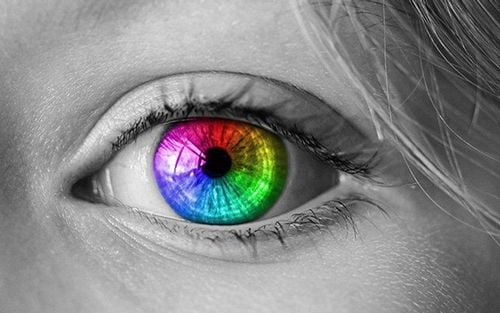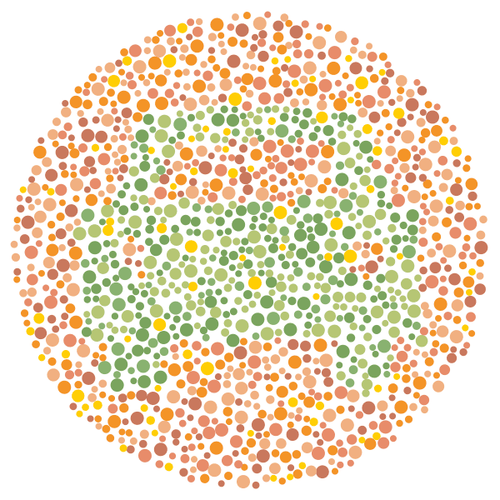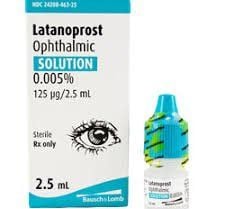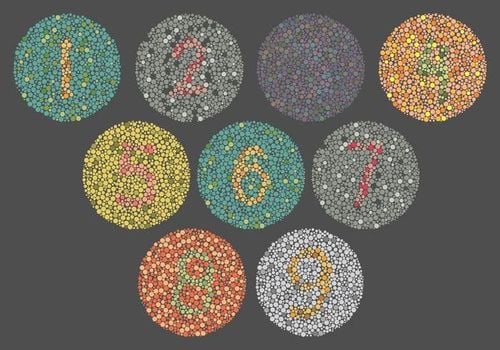This is an automatically translated article.
The article was professionally consulted with Master, Doctor Hoang Thanh Nga - Ophthalmologist - Department of Medical Examination & Internal Medicine - Vinmec Ha Long International General Hospital.Color blindness is a condition in which it is difficult for the patient to distinguish certain types of colors. Color blindness can be caused by many causes, if the cause is due to genetic factors, it cannot be cured. However, we absolutely can take measures to improve and live with it.
1. What is color blindness?
Color blindness, also known as chromosomal disorder, is a condition in which the eyes cannot distinguish the colors of objects or when mixing these colors together. Depending on the severity of color blindness, the ability to perceive colors is reduced or completely unable to see colors.
We can see colors because the retina is a layer at the back of the eye that is sensitive to light, there are two types of cells: rods and cones. Rod cells work in dim light and cone cells respond to brighter light. Both of these cell types respond to color. Their signals travel through the optic nerve to the brain, where they are combined to produce all of the colors. About 12% of women have an extra type of cone that allows them to see 100 times more colors than others.
When being color blind, it means there is a problem with at least one type of hat. Those cones may be missing, or they may be of a different color than we need to see. They may have one or more problems at the same time that prevent them from sending your brain the right information. Since the cones also help you see the small details of what you're looking at, color blindness can also make it less subtle, making it harder to see small details.
Color blindness is divided into two types including:
Red and green color blindness: This is the most common type of color blindness, you cannot distinguish some shades of red and green. It can range in severity from barely distinguishing to not being able to see the color at all. Inability to see blues and yellows: There is a pattern of color blindness that confuses some shades of green and yellow. Just like blue and red, this body also manifests in varying degrees from severe to mild.

Bệnh mù màu là một trong các bệnh lý nhãn khoa
2. Causes of color blindness
Color blindness can be caused by some of the following:
Related to genetic factors: Most people with color blindness are congenital. That's because it usually starts with the genes you get from your parents. Those genes don't give your body the right instructions on how to make the blue, red, and green pigments for your cone cells. Without the pigment, the cone cells cannot perceive color. This gene is located on the X sex chromosome, so the disease can be found in both men and women, appearing at an early age. However, the incidence of this disease is much higher in men than in women. Medical conditions: Color blindness can affect a small number of people with certain medical conditions that are not caused by genetic factors. Some eye diseases that can lead to color blindness include: Leukemia, Parkinson's disease, Alzheimer's disease, sickle cell anemia or alcohol use related disorders. Drugs or certain chemicals: Certain medications including medications for heart disease, high blood pressure, erectile dysfunction, neurological conditions, or medications for mood disorders can cause color blindness as a side effects. Color blindness can also result from frequently working with chemicals such as fertilizers or solvents. However, color blindness caused by these chemicals is not common. In addition, there are a number of other causes such as: Due to trauma to the eye area, old age makes the color-recognition cells aging, which also makes it difficult to distinguish colors.
3. How to detect color blindness?
Often we don't know if a child has this condition until they begin to learn colors. Sometimes it's harder to spot than by going to school and having trouble learning materials that require the use of color. The manifestations of color blindness in children are sometimes difficult to detect if it is mild, so it is necessary to check if the child has color blindness when the child is about 4 years old. It is especially important to check when someone in the family has this disease.

Người bệnh mù màu được phát hiện thông qua một số bài kiểm tra thị lực
To diagnose the disease, doctors will test your ability to perceive colors. The main way to tell if someone is colorblind is the Ishihara color test. Here's how to use a book with pictures of dots in different colors. If you see the correct color, you will spot some other shape in each image.
If you are color blind, you won't be able to tell the difference between shapes, not seeing shapes in some or all of them.
4. How to treat color blindness
Color blindness usually does not affect overall health and usually only affects the patient's quality of life. However, they can cause some accidents if traffic lights are not discernible. Color blindness currently has no cure if it is related to genetic factors. However, researchers are finding ways to treat genetic color blindness by helping the cone cells work better. Animal tests have shown positive results, and human trials known as clinical trials are underway. If color blindness is caused by drugs or other causes, we can improve it by treating the cause.
Although most of us don't have the most effective treatment yet, we can live with it by:
Apps for mobile phones or tablets that can tell you something color. When you take a photo and tap a spot in the photo, the app tells you its color. Some apps can even indicate shades of colors. Use lenses that allow color perception: If you have green and red color blindness, special lenses may allow you to see colors more clearly. However, its effectiveness is still controversial, some professions such as pilots are not allowed to use this type of glass. Form a habit: You can ask someone to help you put labels on your clothes to let you know what color they are, so you can choose the right things. Organize your closet so that clothes you can wear together hang close together. You can also memorize the order of colors in different objects, such as traffic lights, to prevent traffic accidents. In addition, people with color blindness should limit self-driving in crowded roads and when they cannot memorize traffic lights to avoid causing unnecessary accidents.
=>>Advice from Master, Doctor Hoang Thanh Nga - Ophthalmologist - Department of Medical Examination & Internal Medicine - Vinmec Ha Long International Hospital: Colorblind patients need to see a doctor to determine the cause and degree of the disease so that appropriate treatment can be used to avoid the impact on work and life caused by this disease. Vinmec International General Hospital has full human resources and modern equipment to help diagnose and treat eye diseases.
Follow Vinmec International General Hospital website to get more health, nutrition and beauty information to protect the health of yourself and your loved ones in your family.
Please dial HOTLINE for more information or register for an appointment HERE. Download MyVinmec app to make appointments faster and to manage your bookings easily.
Reference source: webmd.com












